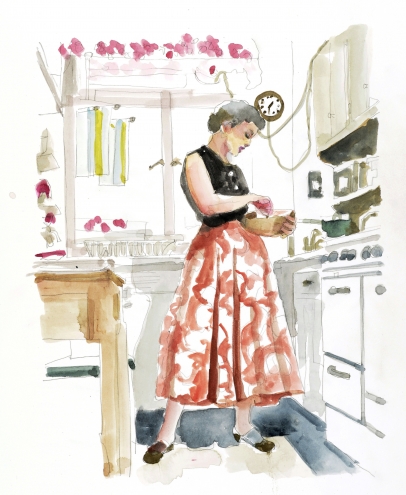The Unequal Kitchen
Do you can food? Tend a garden? Bake your own bread?
Does it feel like a lot of extra work?
If you’re a woman and you feel like you carry more than your fair share of the workload when it comes to putting fresh, local and organic food on the table, you’ve got a lot of company. You might even be working a third shift.
Boise State University Professor Rebecca Som Castellano looked at alternative food systems and found that the division of labor—centered around buying local produce, tending gardens and procuring food in ways that take consumers beyond the conventional produce aisles at Walmart—mirrors the gender divide that we often see in household labor and our broader society.
Women tend to devote more time to cooking, cleaning and other household chores than their male partners and often pull what sociologists call a “second shift.” And Boise State sociologist Rebecca Som Castellano found the division of labor that surrounds alternative food systems looks no different. That means some women pull a “third shift.”
For Som Castellano, food does much more than nourish the body. It can serve as a window into our social world and tell a story about our culture, who we are and how we relate to one another. The story Som Castellano heard when she recently peered through the window of alternative food systems sounds a lot like old-fashioned gender inequality.
“It was with the rise of agriculture that we started to see more of a strict division of household labor,” Som Castellano says.
Som Castellano’s research suggests little has changed since more egalitarian hunting and gathering groups planted seeds, rooted communities and began dividing labor along gender lines. Som Castellano sees a lot of irony in these findings.
“For a lot of people, engaging in alternative food is about politics—it’s about equality, it’s about improving the lives of people and the environment. Yet it turns out [that] because of this additional work, it furthers inequality for some women,” Som Castellano says.
Som Castellano’s work injected her into the lives of women who were not only more likely to invest more time and physical labor into picking local produce, shopping at farmers markets or engaging in a host of alternative food system practices than their male counterparts, but they often put emotional labor into their efforts, as well. For some, this carried a heavy burden through additional stress. And for at least one subject, it strained her marriage.
Som Castellano found that class also played a role in the time women spend investing and participating in alternative food networks.
She interviewed a wealthy woman who found alternative food network participation so time consuming that she hired help to assist with the work. On the other end of the socioeconomic continuum, she found women who pulled double duty by volunteering at farms so that they could get a break on food costs. Other women simply couldn’t afford to participate in alternative food systems.
“There were some women that were, like, ‘Yeah, I have all of these concerns about the food system, I feel political about it, there’s all these things I want to do. But I don’t do them because my local farmers market doesn’t accept food stamps and I don’t have a car and I can’t drive out to the farm and the CSA is too expensive. I don’t have $500 at the beginning of season,’” Som Castellano recounts.
Her research fuses two fields of study—gender studies and food politics—that don’t often intermingle and, in doing so she sheds light on our gendered relationship with food. Her research also highlights gender inequality in broader society. “Gender socialization continues on,” Som Castellano says.
She adds that we have strong ideas in our society that women are innately better at caring activities, such as insuring our families eat healthy food. “We mostly are socialized to be those care-givers. Providing food for families involves a lot of skill. I talk about how it involves a lot of physical labor, emotional labor and mental labor. Those are all things that we are taught. We’re taught how to cook and shop. We’re taught how to plan a meal and how to make a grocery list,” she says.
“We can be socializing our children better,” Som Castellano adds, noting we also need to look beyond the individual level for change because many gendered messagescomefrom public policy and institutions. “We need to be holding people accountable and corporations accountable at a higher level,” she says.





